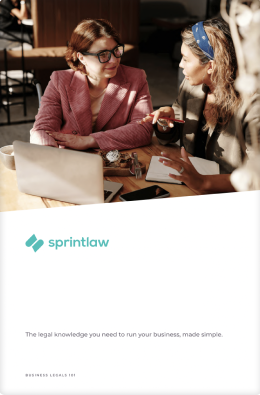Contents
This article is all about trade marks – What are they? Why do we need them? How do they work?
For starters, everyone knows that you can’t just copy the Apple logo and start a new smartphone brand called ‘Apples’. But why is that?
Imagine for a second you did that. You made a new company called Apples and the logo was a picture of an apple just like the Apple logo.
When you release your new phone, you could be quite successful! Lots of people would buy it because they’d be confused – they would think you were the real Apple.
That’s why trade marks exist.
Apple has put a lot of time and money into building a recognisable and trusted brand. If another small company could piggy-back off this hard work just by making a very similar name and logo, what would be the point?
Aside from the reputation of the brand, customers would also be disappointed by the product. They bought something thinking it was a genuine Apple product, only to find out it was a cheaper, lower quality version.
To avoid this very situation, Apple has registered a trade mark of their name, logo and other features of their brand that make them recognisable to their customers.
So, how does a trade mark actually protect a brand like this?
What Is A Trade Mark?
A trade mark is a type of “Intellectual Property”. That is, property that’s intangible (unlike, for example, a house or car).
If you’re starting a business, it’s likely you’ve heard of intellectual property (IP) before.
There are different types of IP that protect the different intangible assets of your business. Trade marks are one type, that is used to protect your business’ image, brand and reputation.
A trade mark is usually the name of a business, a logo, or a slogan. But, a trade mark can take many other forms such as a shape, colour, sound or scent – anything that allows you to distinguish yourself from other businesses.
For example, did you know that Toyota has a movement trade mark for the ‘Toyota jump’?
In Australia, trade marks are registered with a government body called IP Australia.
When you register a trade mark, you get certain legal rights over the registered trade mark.
Why Register A Trade Mark?
When you register a trade mark with IP Australia, you get the exclusive, legal right to use the registered trade mark for certain classes of business activities.
This means you have the right to take legal action against anyone using your trade mark without your consent.
Think back to the example of the ‘Apples’ phones.
Imagine now you’re in the position of the real Apple. If you saw someone copying your name and logo, you would be pretty angry!
Since you have a registered trade mark for you name and logo, you can actually take legal action to stop ‘Apples’ from copying your brand.
You may even be entitled to compensation for the business you lost from the customers who were confused and accidently bought Apples’ phone instead of Apple’s phone.
It is pretty confusing for the customers, right!
Which is why a trade mark is so important.

How Is A Trade Mark Different To A Registered Business Name?
Speaking of registration, you’re probably thinking about your registered business name.
Many businesses get confused about the difference between a trade mark and a registered business name – which is fair enough!
It is a legal requirement to register your business name if you’re carrying on business under that name, whereas it’s not a requirement to register a trade mark.
The difference is, a trade mark gives you all those rights we just discussed (i.e. the exclusive right to to use the registered trade mark for certain classes of business activities).
A registered business name won’t give you this level of protection.
Basically: If you really want to protect your business name and reputation, you should register a trade mark.
Are There Any More Reasons To Register A Trade Mark?
If you weren’t convinced already – yes, there are more reasons.
If you haven’t gone through the process of registering a trade mark, how do you know that you are not the one infringing on someone else’s mark?
Obviously you wouldn’t do it on purpose. But it can happen – if you’ve thought of a great logo design on your own, but what if someone else had already thought of something very similar before you and they registered it as a trade mark?
Then you go about your business and have a lot of success, only to get hit with a lawsuit a few years later by the registered trade mark owner.
Not ideal.
If you had tried to register the trade mark for your logo design in the first place, you would have discovered that another similar trade mark already existed. Then, you could’ve made a couple of changes to your logo, registered it with no problems, and avoided a huge headache for your business.
You also would’ve avoided wasting time and money on building a brand that is infringing on another trade mark.
Ok, So I Want To Register A Trade Mark. Now What?
Registering a trade mark can be a confusing process. We’ve broken it down into 4 steps:
- Deciding on your trade mark
- Deciding on your classes of goods or services
- Checking if your trade mark(s) are available
- Making your application
- Completing the registration
Let’s go through them now.
1. Deciding On Your Trade Mark
When you are trying to decide what you should register as a trade mark, ask yourself:
- How do your customers recognise your brand?
- Do they recognise your business name, logo or both?
Thinking about how your customers recognise your brand is really important – for example, what comes to mind when you see golden arches, or three stripes?
The business name is often the most recognisable thing about your brand. But if your logo is an important part of your brand, it’s definitely worth trade marking it as well!
It’s also worth noting that there is a difference between registering a word and registering an image.
If your logo contains the name of your brand, this does not automatically mean that the name would be protected. Only the logo image containing the name is protected.
To actually protect other people from copying your business name, you would need to register the word itself as a trade mark too.
Of course, if you’re a startup and the cost of registering multiple trade marks is out of your budget, you may want to get some guidance on the best option for your business. If this is something you’re interested in, let us know and we’d be happy to help!
2. Deciding On Your Classes Of Goods Or Services
Remember when we said that a trade mark gives you the exclusive right to use the registered trade mark for certain classes of business activities.
It’s time to think about these ‘classes’.
When you’re applying to register a trade mark, you need to choose the classes of goods and services you want to register your trade mark in.
This limits the scope of your registration to the goods and services that you actually trade in.
The reason for this is to give businesses in different industries more options for what to register. It would be unfair to register a trade mark in an industry where you had no intention whatsoever to do business!
What Are The Classes?
There are 45 classes of goods or services you can choose from. Classes 1-34 are for goods, and classes 35-45 are for services.
These classes are like categories of goods or services in similar types of industries.
It’s worth thinking about it and choosing the right class from the outset. That way, you’re getting the best protection for your trade mark and it saves you from having to make another application down the track.
How Do I Choose The Right Class?
When trying to decide which class or classes to register your trade mark under, you should ask yourself:
- How does my business make money?
- What industry is my business in?
- How do my clients and customers recognise my business?
- Am I providing goods or services?
Once you’ve got a clear idea of what your business does, have a look at the Trade Marks Classification Search on the government website to get a feel of the different classes that might apply.
Be Broad But Not Too Broad
Try to choose classes that are not confined to one of your answers to the above questions.
It is important that the class you choose for your goods or services is broad enough to encompass all aspects of your business and your potential to growth.
However, if you go too broad, you might expose yourself to unnecessary liabilities and challenges for non-use – so make sure you strike the right balance!
What Happens If I Choose The Wrong Class?
If you register your trade mark in the wrong class or in a class that is not entirely relevant to your business, you may be missing essential protection that you need.
You also risk paying much more for your application than you need to – keep in mind that the total cost of your trade mark application depends on the number of classes you select.
If you’re unsure about what is best for your business, it’s often a good idea to speak to a lawyer for some expert advice and guidance.

3. Check Your Trade Mark(s) Are Available
You can check for trade mark availability with IP Australia’s new free checking tool. The tool will give you an indication if there are already trade marks that might be similar to your proposed brand or name.
4. Make Your Application
Once you’ve decided on your trade mark and the classes you want to register, you’re ready to make your application.
You can choose to submit your trade mark application yourself with IP Australia’s new trade mark checker – which makes it easy for companies to check trade mark availability and complete the application process in minutes.
Alternatively, you can seek assistance with a trade mark specialist from Sprint Law to complete your application.
5. Completing The Registration
After you make the initial application, the entire process for registering a trade mark can take several months.
It depends on how complex your trade mark is, but it can take at least 7.5 months for it to go through examination, advertisement and registration processes.
It’s quite a long process, so it’s a good idea to get started as soon as possible.
Once IP Australia has finished processing the application and there are no issues, you will have a registered trade mark – congratulations!
Trade Mark Quick Questions
Still have questions about trade marks?
Here are some common questions that businesses ask us:
How Long Do Trade Mark Registrations Last?
Trade mark registrations last for 10 years. You can apply to renew the registration indefinitely.
Are Trade Marks International?
You may have noticed we only talk about IP Australia in this article. That’s because if you follow this process, your trade mark will only be registered in Australia.
Every country has its own system of trade marks, so you’ll need to consider the trade mark laws of each country to be fully protected.
Luckily, most countries are part of an international treaty called the Madrid Protocol, making it easier to lodge for international trade marks through the one system.
How Much Do Trade Marks Cost?
There are various fees and costs you need to pay to IP Australia when applying for a trade mark.
These include filing fees, fees for adding additional marks or classes, renewal fees and fees to request more time to respond to an examiners report.
You can check out the specifics of fees and costs for your trade mark here.
Can My Trade Mark Application Be Amended?
When using IP Australia’s new trade mark checker, you may be able to make minor changes for free after you submit your first request. However, if you would like to change the trade mark itself e.g. the way it looks, this costs $150 per class.
If you would like to add a new class of goods or services to your application, this costs $200 per class. These fees are for the examiner to re-assess your request and let you know the new results. Once you have paid the second fee to lodge your application, it cannot be amended.
This may mean you need to start a whole new application if you wish to add or change classes or other aspects of your application.
Can My Trade Mark Application Fail?
Yes – so be well prepared before you consider applying.
There are a number of reasons your trade mark application could be rejected, including if it is filed incorrectly, if it is too similar to an existing trade mark or if it is too descriptive.
That’s why it’s a good idea to get professional advice before applying, as it will reduce the chances of unforeseen issues arising.
What To Take Away…
As you can see, there’s a lot to know about registering a trade mark! But it’s often a worthwhile process to protect what makes your business unique and memorable to your customers.
You put a lot of work into building your brand – don’t let it go to waste!
The biggest thing to keep in mind throughout the whole process: How do your customers recognise you?
It is certainly possible to register a trade mark yourself online, but if you want to make sure you’re doing it correctly, it’s a good idea to speak to a lawyer.
More often than not, getting professional advice about your trade mark is the safest option and often ends up being cheaper in the long run.
A specialist can give your trade mark application the best possible chance of being accepted by IP Australia. That way, you feel informed about the process and more confident that you’ll end up with the best outcome for your business.
If you’d like assistance with registering a trade mark, get in touch and we’d love to speak to you about your enquiry!
Get in touch now!
We'll get back to you within 1 business day.













0 Comments on "Trade Marks – What Are They And Why Do We Need Them?"